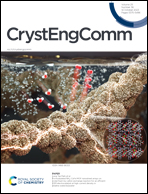Substitution position regulating the excitation-dependent fluorescence–phosphorescence emission of formylphenylboronic acids for single-component white light and anticounterfeiting†
Abstract
With the development of pure organic room-temperature phosphorescence (ORTP), study in excitation-dependent fluorescence–phosphorescence (ExDFPh) dual emission materials is burgeoning. Herein, using formylphenylboronic acid (FPBA) as a prototype, the effect of substitution position on the ExDFPh properties was investigated. Among the three isomers, 4-FPBA exhibits outstanding ExDFPh behavior. Its luminescence color could turn from yellow to white to blue through decreasing the excitation energy. Importantly, dual phosphorescence-emitting species were observed and verified, which updates the understanding of the RTP mechanism. The difference in the ExDFPh behavior is possibly attributed to the RTP performance which is drastically affected by substitution position. Crystal analyses reveal that the intermolecular hydrogen-bond interaction changes from two to one to zero-dimension with varying substitution patterns from para- to meta- to ortho-position, which would affect the RTP emission. This is further proved by the comparison with the corresponding boronic ester, which contains no typical hydrogen bonds in the crystal structure. Theoretical calculation indicates that the intermolecular interaction would also play an important role in the intersystem crossing of the higher-lying singlet excited state. Based on the multi-color emission, potential application in anticounterfeiting is exhibited.



 Please wait while we load your content...
Please wait while we load your content...